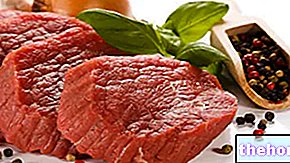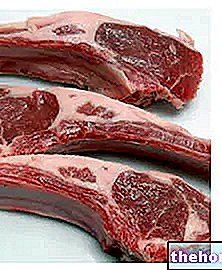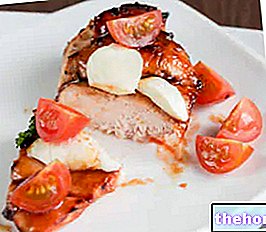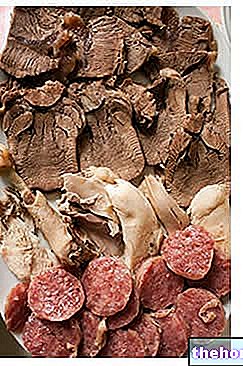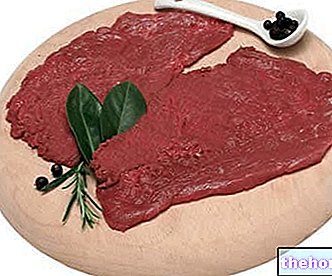What is the Carpaccio
In common parlance, carpaccio means a recipe based on raw meat (bovine or equine), lean and poor in connective tissue, cut very thin or beaten to a thickness of about one millimeter; associated seasoning and side dish vary according to the individual recipe.

NB. The preparation of the carpaccio does not necessarily require the use of chemical cooking in lemon juice or white vinegar, sometimes erroneously called "marinade".
Types
Carpaccio could be divided into several categories respecting various criteria. The simplest concerns the nature of the food: meat, fish products, eggs, cheeses, vegetables and fruits; of the same, carpaccio can be differentiated: fresh, preserved, raw and cooked.
As for the meat carpaccio, the best known are undoubtedly that of fresh veal and beef (fillet and sirloin), but also of roast-beef, of carne salada or bresaola, of soppressa of ribs, of breast d "goose cooked in the oven, salted tongue, etc.
Regarding those of fish, the most famous are: fresh tuna, sea bass, amberjack, sea bream, croaker, salmon, lobster or lobster etc; but also swordfish and smoked tuna, steamed lobster or lobster carpaccio, octopus suppressed carpaccio, etc.
The egg carpaccio only concern hard-boiled ones, while the cheese ones concern the elastic paste products, such as some pecorino, emmental, fontina cheese, etc.
The carpaccio processing of vegetables and fruits is generally used to give a touch of class to the menu. The best known examples are: melon carpaccio (which goes well with raw ham), citrus carpaccio (which sometimes accompanies raw fish), summer fruit carpaccio (to be included in fresh fish carpaccio dishes), carpaccio of tomato or those of cucumbers, courgettes and peppers (as a side dish in salads or to decorate dishes).
Seasonings
As mentioned, raw meat carpaccio (but also fish carpaccio) does not necessarily have to be chemically cooked in lemon juice or white vinegar. This middle ground between a marinade and a chemical cooking is quite aggressive and, despite increasing digestibility due to protein denaturation totally compromises the taste of the food.
Lemon juice or vinegar, on the other hand, must be used, together with oil, salt and spices, for the final dressing; citrus fruits are very suitable for fish and raw meat, while white vinegar gives a very pleasant acrid note to cooked or semi-cooked meats. Both can be part of a semi-emulsion with extra virgin olive oil; the two versions are called vinegrette and citronette.
Some carpaccio, especially those of meat accompanied with dried fruit or other seeds or cheeses, are enhanced by the addition of balsamic vinegar.
Salt and pepper (ground black or white, green or pink in grains) are almost always present, unlike aromatic herbs and spices, which change according to the season and the main ingredient. The best known: parsley, basil, fresh oregano , marjoram, lemon verbena, mint, citrus peel, etc.
As for the sauces, there is a lot to say. Obviously, it is such a personal and specific condiment that it would be impossible to mention them all. The most generic and widespread ones concern: mustard sauce, restricted or balsamic vinegar glaze, pickled vegetables, stewed onions, green sauces, compotes and jams etc.
Octopus carpaccio
Problems with playing the video? Reload the video from youtube.
- Go to the Video Page
- Go to the Video Recipes Section
- Watch the video on youtube
Nutritional Characteristics
The beef carpaccio is a food that mirrors the nutritional characteristics of the main ingredient. The only significant difference concerns the addition of seasoning fats, that is the extra virgin olive oil. The nutritional translation of a typical and very simple lightly seasoned beef carpaccio (85g of beef sirloin, 5g of extra virgin olive oil, 5g of chopped parsley, 5g of lemon juice; salt and pepper to taste).

Nutritional values (per 100 g of edible portion)
Beef carpaccio is a food that can serve as an appetizer and / or dish.
It has an average energy intake, supplied almost equally by lipids and proteins; carbohydrates are almost absent, as are fibers. Cholesterol is present in significant quantities.
The fatty acids of beef carpaccio are mainly monounsaturated and the peptides have a high biological value.
Among the mineral salts, the most indicative of beef carpaccio are iron and potassium, while as regards vitamins, niacin (vit. PP) is mainly present.
Beef carpaccio is suitable for most diets, except for the nutrition of pregnant women. This is due to the hygienic implications of food; to learn more about this aspect of raw meat carpaccio, it may be useful to read: The Risks of Raw Meat.
Background
The first traces of carpaccio can be traced back to the twentieth century. In fact, only in the mid-1900s, the famous chef Giuseppe Cipriani elaborated this recipe to satisfy the needs of Countess Amalia Nani Mocenigo. She could not eat cooked meat, which is why the cook conceived the dish based on beef sirloin cut so much thin as to look like a sheet. The dish was finished only with the addition of a sauce.
The name "Carpacio" was chosen in honor of the painter Vittore Carpaccio, who used very bright colors in his works (just like the red of raw meat).
Other Foods - Amatriciana Meat Lamb - Lamb Meat Duck - Duck Meat Pork Chop Florentine Steak Boiled Broth Raw Meat Red Meat White Meat Beef Horse Meat Rabbit Meat Pork Meat Vegetable Meat Lean Meat Sheep and Goat Meat Carpaccio Ribs Cotechino Cutlet Snails or land snails Pheasant and Pheasant meat Guinea fowl - Guinea fowl meat Pork fillet Chicken Hamburger Hot Dog Kebab Patè Chicken breast Turkey breast Chicken - Chicken meat Meatballs Porchetta Quail - Quail meat Ragù Sausage Game Zampone OTHER ARTICLES MEAT Categories Food Alcoholic Meat Cereals and derivatives Sweeteners Sweets Offal Fruit Dried fruit Milk and derivatives Legumes Oils and fats Fish and fishery products Salami Spices Vegetables Health recipes Appetizers Bread, Pizza and Brioche First courses Second courses Vegetables and Salads Sweets and Desserts Ice creams and sorbets Syrups, liqueurs and grappas Preparations of Basic ---- In the Kitchen with Leftovers Carnival Recipes Christmas Recipes Diet Recipes Light Recipes Women's Day, Mom, Dad Functional Recipes International Recipes Easter Recipes Recipes for Celiacs Recipes for Diabetics Recipes for Holidays Recipes for Valentine's Day Recipes for Vegetarians Recipes Protein Regional Recipes Vegan Recipes

